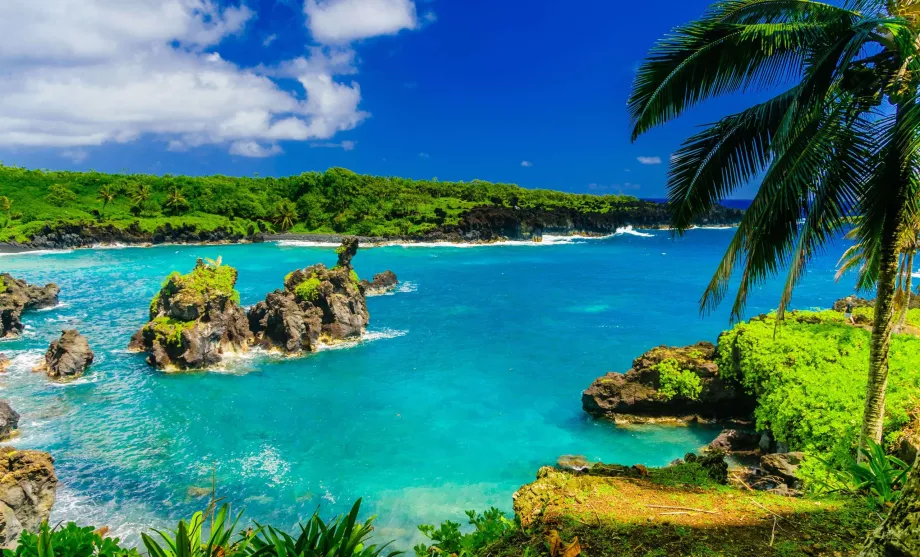Car rental in Maui

Renting a car is practically the only way to travel around Maui, unless you want to stay only in beach resorts that can be reached by bus.
However, there are no bus routes to the most beautiful parts of the island. Driving around the Hawaiian Islands by car is relaxing, however; the locals are used to tourists and there's no need to worry about renting a car on Maui.
Even on Maui, general car rental guidelines apply, and if you're new to this segment, check out our article How to Rent a Car Abroad for the First Time.
Where, when and how to book a car on Maui
When booking a rental car, the general rule of thumb is that the earlier you book, the cheaper it will be, however, in the Hawaiian Islands, prices don't vary wildly unless you're traveling during Christmas or major US holidays.
To book, we recommend using one of the comparison engines of all car rental companies, which will sort the results according to your chosen criteria.
We almost always use Booking.com's comparison engine.
Compare car prices on booking.com
Maui car rental prices
Renting a car on Maui is a relatively inexpensive affair, at least compared to very expensive accommodation and other services. The price depends on the length of the rental (the longer, the cheaper the daily rate) and, of course, the type of car.
- 7-day rental of a smaller car - from 455 usd
- 7-day rental of a jeep or more expensive car - from 680 usd
- Prices and availability of rental cars at Kahului Airport
Always read the detailed rental conditions and especially the insurance conditions, which you can also find on Booking.com. Some rental companies include insurance in the final price, elsewhere you will have to pay extra, between 10 usd and 15 usd per day depending on the type of car and the length of the rental.
International driving licence and other documents
The Hawaiian Islands are part of the USA and to drive here you need an international driver's license, which can only be used in combination with a regular national driver's license.
The Geneva Convention international driver's license is valid in the USA.
Car rental companies usually require a credit card to rent a car, and will often lend you a debit card, but either on less favorable terms or with a very high deposit often exceeding even 1 500 usd.
Petrol prices and where to park
Gasoline is about a dollar a gallon more expensive in Hawaii than in the continental US.
1 gallon of gasoline costs on average 4 usd, which means that converted to liters, you will pay about 1,20 usd for 1 gallon of gasoline on Maui.
Gas stations on Maui are nothing out of the American standard. Usually, "Regular" fuel, i.e. regular unleaded gasoline, will be filled up by the attendant, but you have to pay for it in advance by card at the terminal at the pump, where you have to enter your zip code, which is linked to your card account, to check.
The card will then be charged for the amount you load. If the terminal won't accept your international card (a common problem), you must first pay for the petrol at the attendant's counter, where you choose the exact amount. If you do not draw it, the excess will not be debited from the card.
There are plenty of petrol stations in the biggest cities, don't rely on them in the countryside.
Parking is relatively difficult at the natural sights along the Road to Hana, as there is very little space along the road. Some car parks at nature reserves charge around 10 usd.
Traffic and traffic regulations
Maui is crisscrossed by a good network of roads, all of which are free. Quick connections on three straight roads run between Kahului and the resorts of Kihei or Wailea-Makena on the south coast, and a major highway also runs west along the southern tip of the island to the well-known resorts of Lahaina, Kaanapali and Kapalua.
Maui's most popular attractions include the iconic Road to Hana winding through the densely forested wild north shore, as well as the high mountain road leading directly to the summit of the over 3,000-foot Haleakala volcano.
The above roads are of very good quality and clearly signposted, albeit with fairly heavy traffic. From Kahului to the west coast in particular, you'll often find a long stretch of cars travelling at no more than 60 km/h.
The rest of Maui's roads can be described as secondary very narrow and very winding roads where driving is more of a worry than a pleasure. A typical example is the popular scenic road number 340, called Kahekili Highway, which winds along Maui's northwest coast and is no more than one car wide in places. Due to its many curves, it is very uncluttered and it definitely pays to be cautious and very defensive here.
Violations are very controlled and speeding, parking at a no parking zone or talking on the phone while driving can get very expensive. Check out the basic traffic rules on Maui:
- Drive on the right (just like in the country)
- the maximum speed limit (always marked with a sign) is 55 mph / just under 90 km/h on roads outside the city and 25 mph / 40 km/h in built-up areas
- you may turn right at a red light unless the sign specifically states "No turn on reg signal"
- at low-traffic intersections you will see "All-way Stop" signs, i.e. there is a "STOP" sign from all directions. The first person to cross the intersection is the first to arrive. If 2 or more vehicles arrive at the same time, you follow the same rules as at Czech intersections.
- talking on the phone while driving is forbidden
- There are no roundabouts on Maui.
Any questions left?
If you have any questions or comments about the article...

